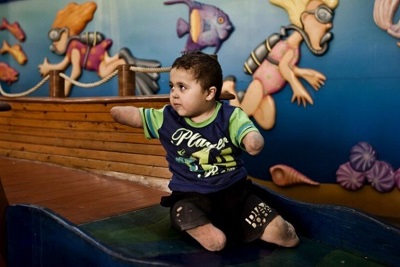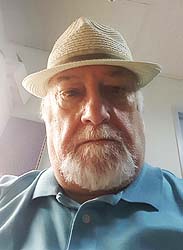 Pallywood znowu podnosi swój ohydny łeb
Pallywood znowu podnosi swój ohydny łeb
Ari Lieberman
Tłumaczenie: Małgorzata Koraszewska
 Zdjęcie Associated Press – dziecko z Gazy, po spowodowanej chorobą genetyczną amputacji kończyn, leczone w izraelskim szpitalu Tel Hashomer.
Zdjęcie Associated Press – dziecko z Gazy, po spowodowanej chorobą genetyczną amputacji kończyn, leczone w izraelskim szpitalu Tel Hashomer.
Arabscy mieszkańcy Judei, Samarii i Gazy, którzy identyfikują się jako ”Palestyńczycy”, i ci, którzy ich wspierają, są niezwykle kreatywni w fabrykowaniu i inscenizowaniu zdjęć i wideo mających propagować kłamstwa i fałszywą narrację, przedstawiającą Palestyńczyków jako niewinne ofiary brutalnych izraelskich okupantów.
Zdjęcia są często fotomontażem lub po prostu są wzięte z innych stref wojennych, które nie mają nic wspólnego z Izraelem. Czasami wideo są produktem starannej inscenizacji przeznaczonej wyłącznie dla kamer, utrwalających sceny, w których rzekomo martwi i ranni w cudowny sposób zdrowieją, gdy tylko kamera przestaje filmować. Często używa się tej taktyki w wyraźnym celu zbierania datków. Ta haniebna i oszukańcza praktyka zyskała nazwę “Pallywood”.
Niedawno zyskałem fascynujący, bezpośredni wgląd w tworzenie Pallywood. Właściciele konta na Twitterze pod nazwą Free Gaza Team z niewiadomych przyczyn zaczęli obserwować mnie na tej platformie mediów społecznościowych. Zajrzałem na ich konto i zobaczyłem wiele drastycznych zdjęć małej dziewczynki, której ramię było oderwane. Rana wyglądała na świeżą, pokazując kość i tkankę. Strona „Free Gaza Team” nazywała dziewczynkę „Noor z Gazy” i dostarczała link do miejsca internetowej zbiórki środków finansowych o nazwie “Social.fund.” Tam widz znowu mógł zobaczyć to samo niepokojące zdjęcie oraz następujący, krótki opis:
“Pomóż Noor z Gazy dostać protezę kończyny.
Free Gaza Team odwiedza ludzi w Gazie, by pomóc ludziom w zaspokojeniu ich potrzeb, kilka dni temu odwiedziliśmy rodzinę Noor na zaproszenie jej matki i znaleźliśmy tę małą, śliczną dziewczynkę, ale niestety, bez lewej kończyny z powodu szrapnela z izraelskiej rakiety podczas ostatniej wojny w Gazie, potrzebuje ona niezbędnych leków zanim zdarzy się gangrena, a potem pomożemy jej dostać protezę, powinniśmy pracować razem, by przywrócić jej uśmiech.
Free Gaza Team.”
Pomijając okropną gramatykę i ortografię, cała historia brzmiała podejrzanie. Gdyby to był opis rzeczywistego zdarzenia, informacja o nim byłoby to na pierwszych stronach „New York Times”, „Guardiana” i w Al-Dżazirze, jako że te publikacje są notorycznie antyizraelskie.
Spróbowałem więc w wyszukiwarce obrazów Google znaleźć coś więcej i natychmiast, w magiczny sposób pojawiło się zdjęcie Noor.
Ale ta Noor nie została zraniona izraelską rakietą w Gazie. W rzeczywistości w ogóle nie była z Gazy. Dziewczynka pokazywana przez Free Gaza Team była syryjskim dzieckiem z Deir ez-Zor, zranionym w wyniku bombardowania przez lotnictwo. Zdjęcia Noor krążyły w mediach społecznościowych przez ponad rok. Kiedy wskazałem to administratorom Free Gaza Team, szybko przestali mnie obserwować i zablokowali mnie. Natychmiast zameldowałem o tym oszustwie do Social Fund, gdzie zareagowano pozytywnie na moją skargę i zakończyli akcję zbierania funduszy przez Free Gaza Team. Pozbawieni platformy Social Fund oszuści z Free Gaza Team otworzyli kolejną ”charytatywna zbiórkę” dla ”Noor”, tym razem w PayPal. Już złożyłem skargę także do PayPal.
Oszustwo dokonywane przez Free Gaza Team reprezentuje samą istotę Pallywoodu i przypomina podobne oszustwa dokonywane przez lata przez Palestyńczyków i ich sojuszników. Jest ich zbyt wiele, by wyliczyć je wszystkie, ale przypomnijmy kilka bardziej znamiennych.
W maju 2017 roku Agenda Narodów Zjednoczonych dla Pomocy Palestyńskim Uchodźcom na Bliskim Wschodzie (UNRWA) opublikowała na swoich stronach i witrynie internetowej zdjęcie, jak napisali, 11-letniej dziewczynki z Gazy o imieniu Aya, na tle ruin zniszczonego budynku. UNRWA twierdziła, że mała Aya była ofiarą okrutnej i barbarzyńskiej blokady izraelskiej, od niemowlęctwa znając tylko nędzę. UNRWA błagała następnie o gotówkę, by wepchnąć ją do swoich już wypchanych kufrów. Był tylko jeden problem, mała Aya była syryjską dziewczynką i sama UNRWA tweetowała jej zdjęcie rok wcześniej z podpisem: “A year in #Syria: http://goo.gl/5cBaOv”. Po wykazaniu oszustwa UNRWA usunęła zdjęcie i wydała spóźnione, wymuszone przeproszenie.
Niesławna członkini ruchu ”Prawda 9-11” i specjalistka teorii spiskowych, Rosie O’Donnell, była winna takiego samego oszustwa. Próbując reklamować to, co nazywała “ograniczoną edycją dzieła sztuki”, zamieściła na swojej witrynie zdjęcie mężczyzny niosącego ranne niemowlę i podpisała je: „Izrael zaczyna bombardowanie Gazy. Ten człowiek niesie niemowlę mniej więcej w tym samym wieku jak to, obok którego siedzę, obserwując sparaliżowana”.
Bloger Aussie Dave zdemaskował w Israellycool „dzieło sztuki” O’Donnell jako oszustwo. Zdjęcie było z Syrii, a dziecko było z Aleppo, ofiara wewnętrznego konfliktu w tym dysfunkcjonalnym kraju. Zdemaskowana oszustka O’Donnell wycofała towar, ale bez przeproszenia.
Jeden z bardziej bezczelnych wyczynów Pallywood, jakie widziałem, dotyczył Mohammeda al-Farra, chłopca z Gazy, urodzonego z rzadką chorobą genetyczną, z której powodu konieczna była amputacja obu rąk i nóg. Jego gazańscy rodzice porzucili go i zaopiekował się nim dziadek, który w rozpaczy zwrócił się do władz izraelskich o pomoc. Dziecko przyjęto w Izraelu do szpitala Tel Haszomer, gdzie al-Farra otrzymał pierwszorzędną opiekę medyczną, a koszty zostały pokryte przez zbiórkę pieniędzy wśród Izraelczyków.
Zaciekły fanatyk, Mohammed Omer, który często pisze absurdalne teksty dla antyizraelskich mediów, takich jak katarska Al-Jazeera, zamieścił zdjęcie chłopca na swoim koncie Twittera z napisem “Jedna z najnowszych #ofiar wojny w Gazie #PamiętajTeDzieci”. Ta sprawa jest wyjątkowo obrzydliwa, bo Omer niemal z pewnością świadomie wziął zdjęcie ze strony internetowej szpitala Tel Haszomer, albo nie przeprowadził podstawowego badania pochodzenia zdjęcia. Zdemaskowany, Omer usunął ten tweet, ale zablokował mnie i innych na swoim Twitterze. Kłamcy nie lubią, jak mówi się im, że są kłamcami.
Pallywood jest podstępną, żydożerczą praktyką, rodzajem nowoczesnego oszczerstwa o rytuale krwi. W wieku nowoczesnej komunikacji i mediów społecznościowych, jest praktyką zdecydowanie bardziej niebezpieczną i szkodliwą niż kiedykolwiek. Fałszywe zdjęcia w ciągu kilku sekund docierają do milionów ludzi i natychmiast tworzą negatywne wrażenie i przekonania. Sprostowania, jeśli są, pozostają ukryte i szybko zapomniane. Można spokojnie powiedzieć o Pallywood, że jest przedsięwzięciem godnym głównego propagandzisty Hitlera, Josepha Goebbelsa.
 Ari Lieberman
Ari Lieberman
Amerykański prawnik, autor wielu publikacji na temat Bliskiego Wschodu.
Zawartość publikowanych artykułów i materiałów nie reprezentuje poglądów ani opinii Reunion’68,
ani też webmastera Blogu Reunion’68, chyba ze jest to wyraźnie zaznaczone.
Twoje uwagi, linki, własne artykuły lub wiadomości prześlij na adres:
webmaster@reunion68.com







